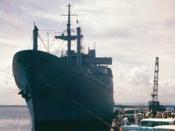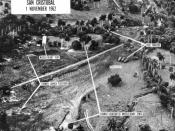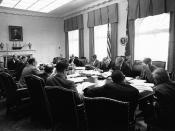The Cuban Missile Crisis was one of the most critical events in American history; the crisis could have led the U.S. into a nuclear war with the Soviets, killing millions of people and would have had huge destruction on both countries. But with President Kennedy's decision to take the safest actions as possible, he saved the U.S. from a nuclear war. President Kennedy was considered one of America's heroes.
On October 14, 1962, the U.S. sent two U-2 surveillance spy planes over Cuba. After taking numerous pictures of the area, the U.S. found out that the Soviet Union was installing nuclear weapons in Cuba. The photographs showed two types of missiles that were being installed. The first one was a medium range missile which was able to go 1100 nautical miles, while the second type was an intermediate missile which was capable of going two times as far as the first missile.
Major American cities such as New York, Washington, and Los Angeles were all within the range of these missiles, and were the most likely targets.
President Kennedy and his advisors immediately decided that the missiles would have to be removed from Cuba anyway possible or the U.S. would be in a lot of trouble. President Kennedy gave the Soviets many warnings to stop, but they continued to build nuclear weapon bases in Cuba, and the U.S. continued to monitor the Soviet's activities. Kennedy and his advisors had to make a plan to counter the Soviet's actions of installing nuclear weapons in Cuba. They came up with a number of possible plans: do nothing and take a wait and see approach; go to the United Nations; remove U.S. missiles in Turkey if the Soviets removed their missiles in Cuba; have a naval blockade on Cuba; or invade Cuba. After...


